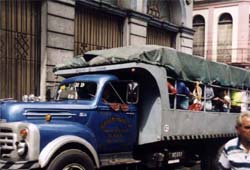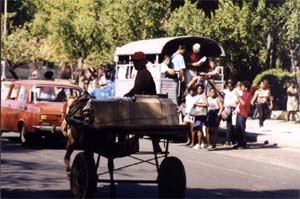Transportation in Cuba
By: Drivers.com staff
Date: 2000-04-05
It's ironic that Cuba, with its high standard of literacy and education and an extensive road network, should suffer from a chronic and severe transportation problem. But getting around the Caribbean's largest island is rendered difficult by the unavailability of vehicles and fuel.
In fact, Cuba has a splendid expressway running almost the length of the island and a first-class network of paved and unpaved roads, most of which were developed to serve the sugar industry. Unfortunately, economic conditions have led to many roads falling into disrepair and drivers unfamiliar with the territory must keep a sharp lookout for potholes.
How Do Ordinary Cubans Get Around?
 Buses
are found throughout urban areas although they're notoriously crowded. Some
enterprising locals have converted large trucks (camiones) into public transport
vehicles and offer trips along the popular bus runs. It's a common enough sight
to see these trucks jammed with standing passengers shaded from the hot sun
by tarpaulin covers.
Buses
are found throughout urban areas although they're notoriously crowded. Some
enterprising locals have converted large trucks (camiones) into public transport
vehicles and offer trips along the popular bus runs. It's a common enough sight
to see these trucks jammed with standing passengers shaded from the hot sun
by tarpaulin covers.
Since 1991, long-distance bus services have been wound back and nowadays getting a ticket can be difficult - advance purchase is usually required with reconfirmation two hours prior to departure.
Trains service all of the regional capitals and are a much more reliable and hassle-free way of getting around Cuba than the buses. Tickets are easy to get and Cuban train travel can be a relaxing and colorful way to see the country. The national airline, Cubana de Aviacion, serves major cities across the island.

Traffic in Santiago de Cuba
With pre-revolutionary automobiles from the 1950s and late Russian models from the 1970s being the only cars available to the ordinary Cuban, many rely on motorcycles, bicycles and even horse and buggy to get them around. The latter, in fact, provide a significant portion of rural transportation.
Many Cubans hitchhike as a means of getting around and locally the activity is known as hacer botella (literally "to make a bottle" with the hand). Government vehicles are legally required to pick up hitchhikers if they have the room, and town exits and major crossroads often have yellow-clad amarillo officials armed with clipboards to organize the Cubans waiting for a ride.
Licensing regulations call for Cuban drivers to pass a theoretical and practical driving examination together with an eyesight test. Drivers must be at least 18 and, as in many countries, various classifications of license are issued depending upon the type of vehicle being driven.
Vehicles are not required to meet any environmental regulations, a fact that is obvious from the amount of blue smoke issuing from the exhausts of some older cars and trucks. With the relatively small number of vehicles on the road, though, this is not as severe a problem as in some Latin American countries.
Cuba's traffic police maintain regular checkpoints along the major routes, enabling them to monitor speeds and check documentation. There is no road tax, although there are a couple of toll roads along the north side of the island near Varadero and Cayo Coco.
Apart from potholes, one of the most frequent hazards is livestock wandering along the roads. Cows, goats and pigs are evident in some rural areas and these quadrupeds appear remarkably well-disciplined. A blast on the horn from the driver and they obediently and unhurriedly step off to the side until the offending vehicle has passed.
Comments to this article have been disabled.
